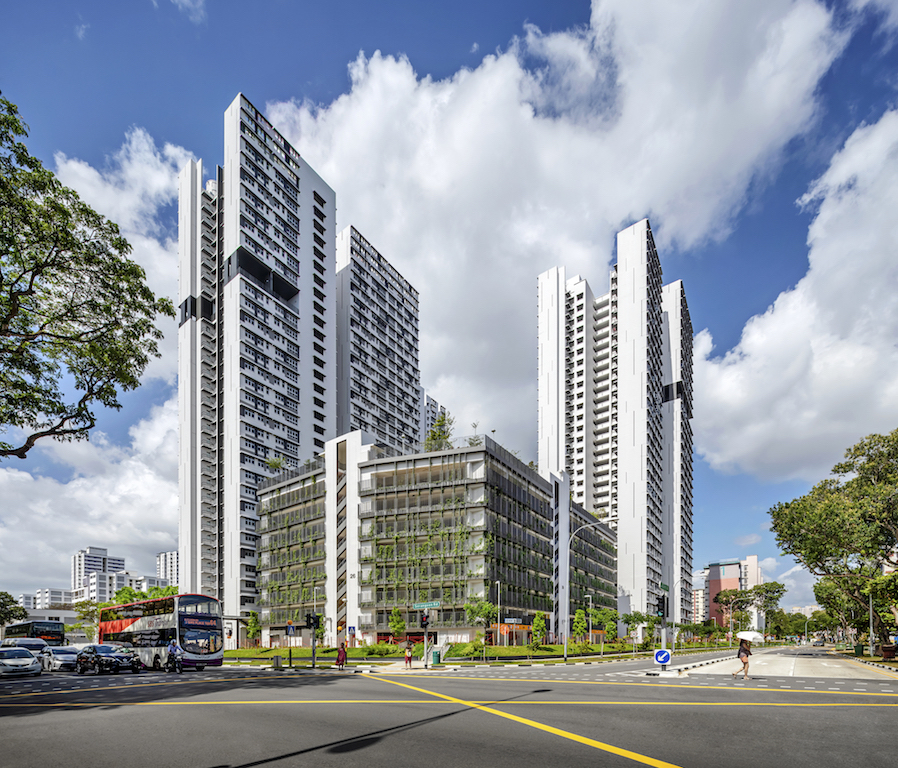Singapore’s Housing Development Board (HDB), the agency responsible for the city-state’s widely-acclaimed public housing celebrated its 60th anniversary last week.
A new project called the St George’s Towers by Look Architects is a testament to how much the HDB housing has evolved. Located in Kallang Whampoa neighbourhood, on the fringes of the central business district, the high-rise residential development presents a new typology in keeping with the evolution in lifestyle and other urban considerations such as mobility, wellness, and connectivity.
St. George’s Towers, a Built To Order (HDB BTO) housing project consists of three blocks of 32-34 storey high-rise apartments, a multi-storey carpark, and an Active Ageing Hub. This project features a rich matrix of shared spaces through unobtrusive design of common spaces and showcases the vibrancy and diversity that is unique to Singapore’s heartlands. Sensitive to the urban fabric, the high-density housing maintains porosity with complementary cycling paths leading to the nearby Park Connector Network (PCN). Green pockets fill the common areas that share the vantage point with the surrounding developments and greenery.
Through an extension of the project’s relationships with its surroundings and other urban dynamics, the architecture studio has created spaces within the project that effectively encourages residents to mingle with each other and establish a community.
The precinct taps into the energy of the PCN through an amicable interface – extending the pedestrian linkway as a sheltered pitstop for cyclists and serving as a marker along the cycling trail with heritage storyboards relating the history of Kallang-Whampoa. Cyclists are welcome to take a break at the landscaped ‘rain gardens’ in the precinct, to take in the sights and sounds of a thriving micro-biosphere. Residents can enjoy the convenience of hopping onto the PCN, which gives direct connectivity to Bishan Park, Toa Payoh Town Park and Kallang Riverside Park. The provision of integrated bicycle parking lots at the base of each residential block can encourage more residents to take up cycling as a hobby, boosting the popularity and dynamism of the PCN as a recreational destination.
Coupling the FSCF (future social community facilities) with the utilitarian MSCP (multi-storey carpark) as a multi-use building along the frontage of Serangoon Road activates the ground level, reviving the liveliness around existing shophouses, many of which are making way for the new precinct. Community facilities such as a childcare centre, elderly day-care and tuition centre are essential support amenities for multi-generational living, and greatly welcomed by residents when they are sensitively situated.
A communal viewing gallery is carved out of each residential tower, offering avantage point from the high-rise blocks. Residents could gather at the viewing gallery to enjoy the fireworks displays during National Day Parade and New Year’s celebrations.
In a reciprocal way, the larger urban fabric receives a positive feedback from the vitality of the precinct, allowing impact of existing infrastructure to be amplified through positive reinforcement. For instance, both the PCN and ABC (active, beautiful and clean) waterway programmes implemented along Sungei Whampoa are enhanced by synergetic interfacing with the precinct – the proposed heritage marker pit-stop providing added interest along the cycling route and greater biodiversity being nurtured by the landscaped rain gardens, a green sanctuary hosting native flora and fauna. The maturing Kallang-Whampoa neighbourhood regains greater vibrancy when young families move into precincts offering multi-generational amenities. As a result, a series of positive reinforcement sets in motion a framework for lasting social and environmental sustainability.
Photos: Joseph Goh [www.infinitude.biz]











